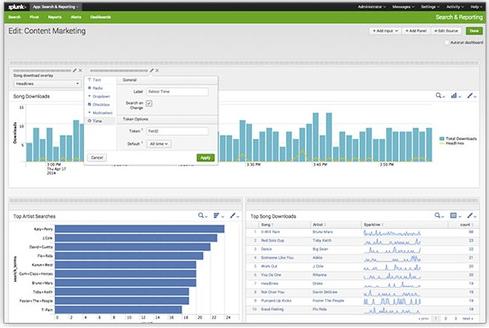

Scenario 2 – Monthly Trend Comparison (when log timestamp and _time field are NOT same).Scenario 1 – Weekday & Weekly Trend Comparison (when log timestamp and _time field are same).Let’s build queries to help us visualize data trends in the following scenarios. To upload data, navigate to the Searching and Reporting view in Splunk Cloud, click on Settings to see the Add Data option, and follow the process.įigure 2 Building Queries and Visualizing Data

The data contains only two columns, DateTime and UserLogins, as shown below.
#Splunk create dashboard free
You can use the Splunk free trials available by following the process here. We will start with uploading the sample data in a CSV file to the Splunk Cloud (trial version). In this demo, let’s use sample data with Users’ Login count for every hour throughout the year 2022. To draw insights and make informed decisions, one must retrospectively look at historical data to uncover trends, patterns, and relationships.
#Splunk create dashboard how to
Based on the lessons learned, our expert is sharing how to create retrospective dashboard queries in Splunk. They have also been instrumental in creating various monitoring and reporting dashboards in Splunk, helping key customer stakeholders by offering critical business insights in a dashboard. Our experts have helped customers analyze, set up, rationalize, and perfect the alerts for maximizing the coverage of applications and infrastructure monitoring with effective alerts put into the right place. PrimeSoft has good expertise on Splunk as we have helped our customers monitor and troubleshoot alerts received from multiple systems in both Production and Non-Production environments for business-critical applications. It indexes and correlates information in a container, making it searchable, and enables the generation of alerts, reports, and visualizations.Īdditionally, Splunk has a large and growing ecosystem of add-ons and integrations with other tools, making it a popular choice for organizations that need a flexible and scalable data analysis solution.

#Splunk create dashboard software
The software can be deployed on-premises or in the cloud, and offers a wide range of APIs and integrations with other systems, enabling users to collect data from various sources easily. It offers a wide range of capabilities for searching, analyzing, and visualizing data, as well as building and deploying custom applications. Splunk is a software designed to collect, analyze, and visualize large amounts of machine-generated data, such as log files, network traffic data, and sensor data. In this post, let’s see how to create Retrospective dashboard queries in Splunk with a simple scenario with a sample data. It is employed in many industries, such as healthcare, finance, and retail, to gain insights into their operations, security, and compliance and make data-driven decisions. Splunk is widely used by organizations to monitor and troubleshoot IT infrastructure and applications.


 0 kommentar(er)
0 kommentar(er)
